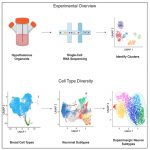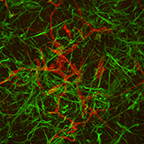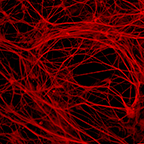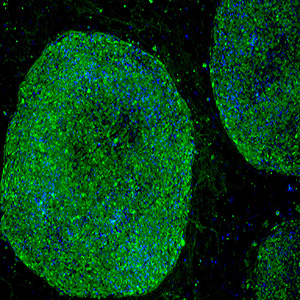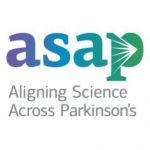Research
The human brain of many individuals is genetically susceptible to neurodegenerative diseases like Alzheimer’s disease (AD) or poor recovery from traumatic injury and chemotherapy. However, pinpointing the genetic elements that promote this pathogenesis, establishing their underlying cellular and molecular mechanisms, and developing therapeutic strategies remain major challenges. These challenges are reflected in the growing patient population and complete absence of therapeutics for Alzheimer’s disease and related dementias. We need new approaches to understand the uniquely human biology that is fundamental to neurodegeneration and innovative technology that enables the development of effective therapeutic and preventative strategies. To fulfill this need, we engineer 3D models of human brain tissue from stem cells and apply these models to understand and therapeutically target risk factors for Alzheimer’s disease and other forms of cognitive impairment.
Our work specifically aims to (1) establish the cellular and molecular pathways underlying neurodegenerative risk factors, (2) target and modulate these pathways as potential therapeutic strategies, and (3) establish pioneering technology and tools that unravel complex genetic, cellular, and environmental interactions in the human brain. Ultimately, our goal is to facilitate a precision medicine approach to understanding and treating neurodegenerative disease.

Joel Blanchard, PhD
Associate Professor
Nash Family Department of Neuroscience
Department of Cell, Developmental & Regenerative Biology
Black Family Stem Cell Institute
Ronald M. Loeb Center for Alzheimer’s Disease
Icahn School of Medicine at Mount Sinai
Publications
Morrone Parfitt, G., Coccia, E., Goldman, C. et al. Disruption of lysosomal proteolysis in astrocytes facilitates midbrain organoid proteostasis failure in an early-onset Parkinson’s disease model. Nat Commun 15, 447 (2024). Link
Qian Wang et al. Molecular profiling of human substantia nigra identifies diverse neuron types associated with vulnerability in Parkinson’s disease.Sci. Adv.10,eadi8287(2024) Link
Sarrafha L., Neavin, DR. Parfitt, GM. Kruglikov, IA. Whitney, K. Reyes, R. Coccia, E. Kareva, T. Goldman, C. Tipon Regine, T. Croft, G. Crary, JF. Powell, J. Blanchard J.* Ahfeldt, T*., Novel human pluripotent stem cell-derived hypothalamus organoids demonstrate cellular diversity. iScience (2023) in press.Link
Louro, L. Suhy, N. Broekaart, D. Bula, M. Pereira AC. Blanchard, J. Modeling the Blood-brain barrier using Human induced pluripotent stem cells. Methods Mol Biol. (2023), PMID: 37300772Link
Goldman, G., Suhy, N., Louro, L., Rooklin, R., Blanchard J., Reconstruction of the blood-brain barrier in vitro to model and therapeutically target neurological disease. JoVe (2023). Link
Blanchard J., Akay, LA., Velderrian JD., von Maydell, D., Mathys, H., Davidson SM., Effenberger, A., Chen C., Maner-Smith, K., Hajjar, I., Ortlund, EA., Bula, M., Agbas, E., Ng, A., Jiang, X., Kahn, M., Blanco C., Laoie N., Liu L., Reyes, R., Lin YT., Ko T., R’Bibo LR., Ralvenius WT., Bennett DA., Cam HP., Kellis M., Tsai L-H. APOE4 impairs myelination via cholesterol dysregulation in oligodendrocytes. Nature (2022) link
Blanchard J., Blenkinsop T., Ghaffari S., Krauss RS., Rendl M., Sturgeon CM., Zwaka TP., Marek ., Millar S, Fulfilling the promise of stem cell biology and regenerative medicine. Science The Frontiers of Medical Research (2021) Link
Blanchard J., Victor M., Tsai L-H, Dissecting the complexities of Alzheimer’s disease with in vitro models of the human brain. Nature Reviews Neurology (2021). Link
Blanchard J., Bula M., Akay, LA., Zhu L., Frank A., Velderrian JD., Victor, M., Bonner, JM., Mathys, H., Lin YT., Kellis, M., Cam, H., Tsai LH. Reconstruction of the human blood-brain barrier in vitro reveals a pathogenic mechanism of APOE4 in pericytes. Nature Medicine (2020)Link
Blanchard J., Tsai, LH., Unraveling the paradox of statins with human neurons: New leads in Alzheimer’s disease. Cell Stem Cell (2019). Link
Tsunemoto R.*, Lee S.*, Szűcs A., Chubukov P., Sokolova I., Blanchard J., Eade K., Bruggemann J., Su A., Sanna P., Baldwin K., Binary reprogramming codes for neuronal identity and diversity. Nature (2018). Link
Blanchard J., Xie, J., El-Mecharrafie, N., Lerner, RA., Baldwin K., Replacing reprogramming factors with antibodies selected from combinatorial antibody libraries. Nature Biotechnology (2017). Link
Blanchard J*., Eade K*., Szucs A., Lo Sardo V., Tsunemoto R., Williams D., Sanna P., Baldwin K. Selective conversion of fibroblasts into peripheral sensory neurons. Nature Neuroscience (2015) Link
Tsunemoto R., Eade, K., Blanchard J., Baldwin K. Forward engineering neuronal diversity using direct reprogramming. EMBO J (2015). Link
Wang Y., Davidow L., Arvanites A., Blanchard J., Lam K., Woo J., Coy S., Rubin L.L., McMahon A. Selective Identification of Hedgehog pathway antagonists by direct analysis of Smoothened Ciliary Translocation. ACS Chemical Biology (2012). Link
Wang Y., Davidow L., Arvanites A., Blanchard J., Lam K., Woo J., Ng J., Curran T., Rubin L.L., McMahon, A. Glucocorticoids Compounds Modify Smoothened Localization and Hedgehog Pathway Activity. Chemistry and Biology. (2012). Link
Ichida J. K*., Blanchard J*., Lam K*., Son E. Y*., Chung J. E., Egli D., Loh K. M., Carter A. C., Di Giorgio F. P., Koszka K., Huangfu D., Akutsu H., Liu DR., Rubin LL., Eggan A Small-Molecule Inhibitor of Tgf-β Signaling Replaces Sox2 in Reprogramming by Inducing Nanog. Cell Stem Cell (2009). Link
*These authors contributed equally to this work
Lab Members

Louise Louro, PhD
Instructor
Louise has a background in central nervous system injury, biomarkers and regenerative strategies, including cell therapies and pharmacological approaches. Her current research is focused on developing multi-cellular in vitro models of neurodegenerative diseases. She enjoys cooking Brazilian-Italian food and walking around the city to find nice little wine and food spots.

Jessica Schwarz, PhD
Post Doctoral Fellow
Jessica obtained her Ph.D. in Neuroscience from the University of Pennsylvania in 2022. Her dissertation research, in the lab of Dr. Amita Sehgal, focused on changes in circadian rhythms with age. In the Blanchard lab, Jessica is focused on studying the functionality of neurons in the context of neurodegenerative disease as well as in the mibrain system. Outside the lab Jessica enjoys baking and cooking (especially for her labmates and friends), going to the theater, and exploring all the restaurants and museums NYC has to offer!

Anna Bright
Doctoral Student
Anna graduated from Vanderbilt University in 2022 with a Bachelor’s degree in neuroscience. Her undergraduate research in Dr. Vivian Gama’s laboratory focused on mitochondrial biology in neurodevelopment. Anna’s current research interests involve using 3D stem cell-derived models to better understand the biological mechanisms of Alzheimer’s disease. When she’s not in lab, you can find Anna painting, thrifting, or roaming around Central Park admiring the dogs.

Camille Goldman
Doctoral Graduate Student

Ana Forton-Juarez
Doctoral Student

Tatyana Kareva
Lab Manager
Tatyana obtained her B.S in Medical Laboratory Science from City Medical College in Odessa, Ukraine. She is supporting an administrative as well as technical side of the research projects in the lab. In her free time , Tatyana enjoys exploring New York City and spending time with family.
![Andrea Headshot[85]](https://labs.neuroscience.mssm.edu/wp-content/uploads/2023/11/Andrea-Headshot85-150x150.jpg)


Andrea Perez Arevalo, PhD
Post Doctoral Fellow
Andrea obtained her PhD in Human Biology from Ulm University, Germany, in 2023. Her research in Prof. Dr. Tobias M. Böckers lab focused on understanding the role of microglial cells in the development of Autism Spectrum Disorders (ASDs). Her current research is focused on understanding the influence of glial cells in the development of neurodegenerative diseases in different genetic variants and environmental conditions. Outside the lab you can find Andrea enjoying music and art around the city, trying new foods, and spending time in nature.
Natalie Suhy
Doctoral Student
Natalie graduated from UC Berkeley in 2021, where she worked in the lab of Dr. David Schaffer and received a Bachelor’s degree in molecular and cell biology. Her background is in stem cell biology, CRISPR gene editing, and 3D pluripotent stem cell cultures for use in cell replacement therapy. She also has prior research experience studying cancer immunology with Merck, and gene therapy techniques with biotech startups. Natalie’s current research interests include modeling of the blood brain barrier, examining genetic components and identifying immunological mechanisms of neurodegenerative diseases. In her free time, she enjoys cooking vegan recipes, going out with friends, and trying new workout classes.
Rikki Rooklin
Associate Researcher
Rikki received her M.Sc. in Bioengineering from New York University with a focus on Biomaterials in 2022. While at NYU, she worked in the Castillo Lab at the Bioengineering Institute, studying the impact of load-induced bone formation in aging and diseased models. Rikki’s current research focuses on material engineering 3D scaffolds used to support the other research in the Blanchard lab. In her free time, she enjoys reading far too many books, traveling, and baking.

Elena Coccia, PhD
Post Doctoral Fellow

Braxton Schuldt
MD/PhD Student
Braxton graduated from Amherst College in 2021 with a Bachelor’s degree in neuroscience. For his undergraduate thesis, Braxton studied the molecular mechanisms of dendritic spine development in the context of autism spectrum disorder. He is currently interested in using stem cell models to study neurodegeneration and explore the potential of neurosurgical transplantation as a therapeutic intervention for CNS diseases. Outside of the lab, Braxton enjoys running, hanging out with friends, and eating Domino’s pizza

Emily Sartori
Associate Researcher
Emily is a recent graduate of Bucknell University with a B.S. in Biomedical Engineering, Summa Cum Laude. During her undergraduate career, she worked in Dr. Brandon Vogel’s and Dr. Olivia (Ngo) Boerman’s labs designing and performing pre-clinical validation on novel hydrogel formulations. She previously worked at AbbVie Pharmaceuticals in the in-vitro and drug metabolism division. In this role, she also contributed to defining directed-differentiation protocols, as well as, functional and analytical characterization methods for hiPSCs. She aspires to contribute to the scientific field by following her passions for regenerative medicine, tissue engineering, and cell biology. In her free time, Emily enjoys running, cooking, and spending time with her family.
![faisal 1[95]](https://labs.neuroscience.mssm.edu/wp-content/uploads/2023/11/faisal-195-150x150.jpg)


Faisal Hayat Nazir, PhD
Instructor
In 2014, Faisal joined the laboratory of Dr. Henrik Zetterberg as a Biologist at the University of Gothenburg, Sweden where he was first introduced to stem cells research. Faisal completed his PhD Program in Medical Science at the University of Gothenburg, Sweden in Dr. Henrik Zetterberg’s laboratory. His research included studying biomarkers of Alzheimer’s disease using neurons and astrocytes derived from human induced pluripotent stem cells and cerebrospinal fluid as models.
Faisal joined Dr. Joachim Burman’s laboratory as a Postdoctoral Researcher at Uppsala University, Sweden. During his postdoctoral training, he developed a cell-based ELISA method to semi quantify immunoglobulins from blood and cerebrospinal fluid samples of multiple sclerosis patients’ binding to neuronal and oligodendroglial cell-lines. He has attracted several travel and project grants during his doctoral and postdoctoral trainings. Faisal has joined Dr. Joel Blanchard’s laboratory to work on Genetic and Environmental Vulnterability to Neurodegeneration in the Nash Family Department of Neuroscience, at the Icahn School of Medicine at Mount Sinai.
Abigail Uchitelev
Undergraduate Researcher
Abigail is an undergraduate student at the Macaulay Honors College at Hunter College pursuing a Bachelor’s degree in Human Biology with the goal of becoming a physician after completing medical school. She is now delving into her strong passion for understanding the intricacies of the human brain as an intern at the Blanchard lab, working with in vitro models of neurodegenerative diseases. Her current research focuses on the retinal pigment epithelium and how it connects to the blood-brain barrier. Abigail aims to contribute to the scientific and medical field by pursuing her interests in regenerative medicine and cellular biology. In her free time, she enjoys spending time with her family, hiking, and experimenting with new recipes.
Soha Sohail
Research Associate
Soha graduated Magna Cum Laude from Wayne State University with a B.S. in Public Health and Biochemistry. She is currently advancing her academic journey by pursuing a Master’s degree in Neuroscience at Icahn School of Medicine, where her research delves into the intricate effects of Parkinson’s Disease genetic variants on distinct cell types, utilizing pluripotent stem cell models. Her passion for molecular biology was fostered during her undergraduate research in the labs of Dr. Jennifer Condon and Dr. Jeyasuria Pancharatnam, where she investigated the regulation of endoplasmic reticulum stress responses and their impact on gestational length. Soha is interested in advancing her scientific knowledge and improving human health, with aspirations to bridge science and medicine by pursuing a career in medicine. Outside of lab, Soha enjoys exploring NYC, perfecting her culinary skills, and spending time with her family.


Jennifer Strong
Doctoral Student
I’m interested in 3D stem cell models to explore Neurodegeneration and aging, specifically in the context of Alzheimer’s, Parkinson’s, & ALS
Alice Buonfiglioli, PhD
Post Doctoral Fellow
Alice obtained her Ph.D. in Neuroscience from Charité University of Medicine in collaboration with the Max-Delbrück-Center for Molecular Medicine in Berlin, Germany, in 2020. Her graduate and postgraduate research has focused on investigating microglia in physiology and pathology in murine and human stem cell-derived 2D and 3D models. She is currently studying genetic variants in microglia in the context of neurodegeneration using iPSC technology. Outside the lab, Alice plays volleyball, enjoys music and traveling.
Alumni
| Ricardo Reyes | Harvard Medical School, MD Student |
| Sasha Frank | Icahn School of Medicine, MD/PhD Student |
| Lily Sarrafha, PhD | Denali Therapeutics, Scientist |
| Gustavo Parfitt, PhD | Genentech, Scientist III |
Projects
Areas of Investigation
Blood-Brain Barrier (BBB)
The BBB feeds the brain with nutrients and oxygen while also protecting it from peripheral pathogens and insults. It is increasingly recognized the BBB also has a prominent role in neurodegenerative disease. Numerous genes associated with risk for neurodegeneratoion are expressed in the cells that constitute the BBB where they likely directly influence disease susceptibility and pathogenesis. For example, APOE is highly expressed In the BBB and the APOE4 variants is known to correlate with increased amyloid deposition on cerebral vasculature. In addition to being a location of amyloid deposition, the BBB also forms a highly selective barrier that prevents more than 98% of all small molecules from entering the brain. By developing an iPSC-based model of the BBB, we aim to understand i) how the BBB contributes to neuorodegeneration susceptibility and pathogenesis and ii) develop a physiologically reliable test to asses drug-brain penetration across diverse genetic populations.
Myelination
It is emerging that oligodendrocytes (OLs) and myelin degeneration play a central role in neurodegeneration and cognitive aging. In the human brain, the total myelin volume increases until around the fourth or fifth decade of life after which it sharply declines. Therefore, myelin degeneration is thought to be a fundamental mechanism leading to cognitive changes associated with aging. In most neurodegenerative diseases, myelin degeneration is accelerated. For example, the majority of Alzheimer’s disease (AD) patients exhibit deficits in white matter compared to healthy individuals of the same age. Surprisingly, in populations at high risk for developing AD, several imaging studies identified that the loss of white matter begins prior to cognitive decline. Likewise, in rodent AD models, myelin deficits are observed prior to the formation of amyloid plaques and neurofibrillary tau tangles, the classical pathological hallmarks of AD. At the molecular level, many of the genes implicated in the development of sporadic AD could directly influence OL biology and/or myelination. Collectively, this suggests that myelin degeneration may be one of the earliest biomarkers and a key pathological mechanism underlying cognitive decline in AD and aging. Despite these implications the role of OLs and myelin degeneration in AD pathogenesis remain largely unclear. This is likely due to species differences in myelin biology, difficulty in procuring mature OLs, and limited assays for human myelination. Through developing technology to study human myelination in a dish we aim to gain deeper insight into how myelination is altered during neurodegeneration and the effect of genetics and the environment on these processes.
Neuro-Immune-Vascular Brain
In the human brain, neurons, microglia, and the blood-brain barrier are dynamically interconnected. How these connections are formed during development, maintained in homeostasis, and degenerate with age remain poorly understood. It is also largely unclear how human genetic diversity alters neuro-immune-vascular interactions to influence susceptibility to disease and age-related cognitive impairments. To approach these questions, we have developed an in vitro Neuro-Immune-Vascular tissue.
Multi-cellular integrated brain tissue (miBRAIN)
Numerous preclinical drugs have effectively cured Alzheimer’s disease in mice and other vertebrate models. However, all of these once-promising candidates have ultimately failed to show efficacy in human clinical trials. There are general concerns about the fidelity of rodent models and most of the genetic variants associated with increased risk for Alzheimer’s disease in humans are not conserved between species. Therefore, intermediate models that exhibits AD pathology in human tissues may better predict clinical outcomes. To address this, we are creating a multicellular integrated Brain tissue (miBRAIN) composed of seven disease-relavent cell-types. Future studies will apply this models to 1) pinpoint cellular and molecular mechanisms that promote risk for age-related cognitive impairment 2) screen and stratify drug response and efficacy across diverse genetic backgrounds 3) investigate how adverse life events such as traumatic brain injury or chemotherapy increase susceptibility to age-related neurodegeneration.
Awards
2021 Friedman Brain Institute Scholar Award
2019 – ISSCR Merit Award
2019 – ISSCR Travel Award, International Society for Stem Cell Research meeting, Los Angles, CA.
2018 – Postdoctoral Fellowship in Aging Research, Glenn Foundation of Medical Research
2014 – Betty Jean Ogawa Memorial Poster Award, International Society for Stem Cell Research
2014 – ISSCR Travel Award, International Society for Stem Cell Research meeting Vancouver, BC.
2014 – Keystone Scholarship, Keystone symposia on Stem cells and Reprogramming, Olympic Valley, CA.
2011 – Pre-doctoral Fellowship, California Institute of Regenerative Medicine.
2010 – ISSCR Travel Award, International Society for Stem Cell Research meeting San Francisco, CA.
2010 – Biotechnology Master’s Thesis Honorable Mention, Harvard University
2009 – ISSCR Travel Award, International Society for Stem Cell Research meeting, Barcelona Spain.
Lab News
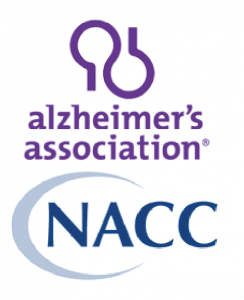
Congrats to Jessica for wining the Alzheimer’s Association/NACC New Investigator Award! link
 Gustavo’s DJ1 paper published in Nature Communications! link
Gustavo’s DJ1 paper published in Nature Communications! link
Lily’s hypothalamic organoid paper was published in iScience! link

Lab receives grant to develop models of TBI using iPSC-derived human brain tissue link
 Elahi, Blanchard, and Raj team awarded Grant from CZI link
Elahi, Blanchard, and Raj team awarded Grant from CZI link
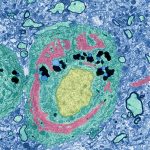
APOE4 myelin paper published in Nature
 Camille wins a NRSA F31 predoctoral fellowship!
Camille wins a NRSA F31 predoctoral fellowship!
 Louise wins ISSCR travel award and ISSCR Merit award!
Louise wins ISSCR travel award and ISSCR Merit award!
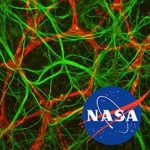 Lab awarded a grant from NASA link
Lab awarded a grant from NASA link
 Lab awarded a grant from the Cure Alzheimer’s Fund link
Lab awarded a grant from the Cure Alzheimer’s Fund link
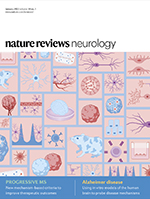
Nature Reviews Neurology article featured on Cover link
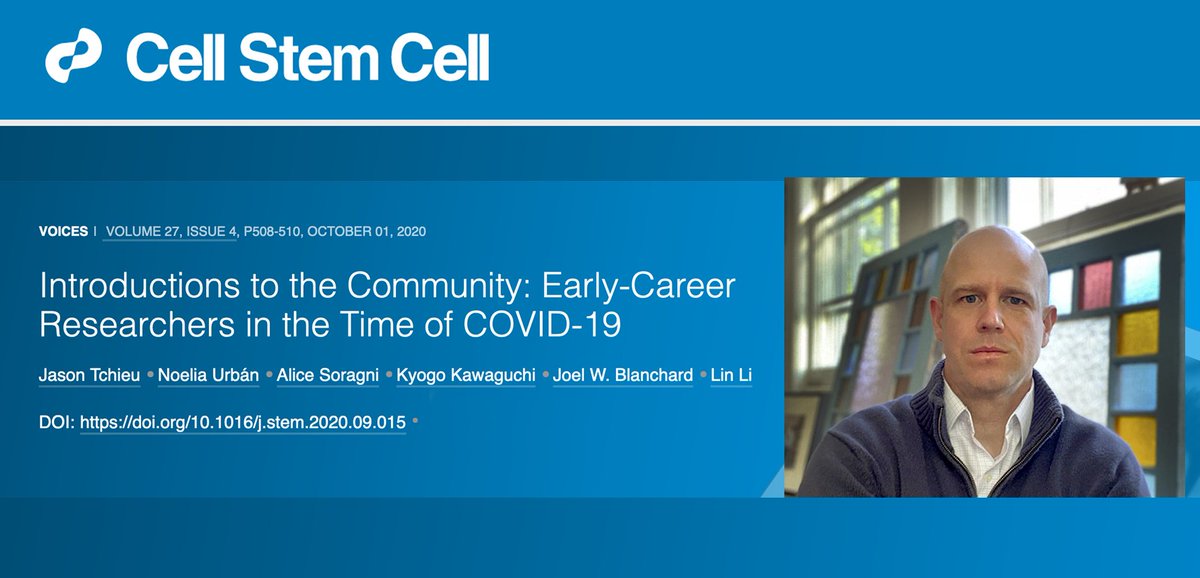 Cell Stem Cell Profiles of Early-Career Researchers in the Time of COVID-19
Cell Stem Cell Profiles of Early-Career Researchers in the Time of COVID-19Funding
Active
Extending the longevity of human brain models for longitudinal analysis
Active
Establishing the molecular and cellular mechanisms and biomarkers of APOE4-mediated susceptibility to tau-related cognitive impairments
Studies have demonstrated that the strongest risk factor for Alzheimer’s disease APOE4 increases the severity of Tau pathology and cognitive impairments, but the mechanisms are unknown. Using our in vitro brain technology, we will dissect the cellular and molecular mechanisms by which APOE genotype modulates Tau phenotypes. This will reveal signaling pathways that we will investigate as therapeutic targets using chemical and genetic approaches.
Implications of Polyamine and Glucosylceramide Transport for Parkinson’s Disease (IMPACT-PD)
This grant seeks to understand the role of ATP13A2 and ATP10B in PD-associated lysosomal dysfunction. Our group will collaborate with other investigators in establishing, validating and characterizing all in vitro cell models. We will lead the efforts to generate midbrain dopaminergic neurons, midbrain patterned astrocytes, co-cultures and phenotyping efforts in hPSC derived differentiated cells.
UG3-NS115064 Construction of an integrated immune-vascular brain- chip as a platform for the study, drug screening, and treatments of Alzheimer’s disease
This grant builds off our iBBB technology by incorporating additional cells types to generate a human multicellular integrated brain tissue (miBrain). Using iPSC lines from which we have matched post-mortem brains we will develop, optimize, and validate this human brain-on-a-chip technology as platform for the study, screening and therapeutic optimization of Alzheimer’s disease.
R01NS114239 Understanding cell-type vulnerability and oxidative stress pathology in Parkinson’s Disease using isogenic human dopaminergic neurons
This grant investigates site-specific vulnerability of dopaminergic (DA) neurons in Parkinson’s Disease (PD) using hiPSC and organoid models. The mechanism of site-specific DA neuron vulnerability in PD is not yet known; insight into these mechanisms will uncover new therapeutic opportunities in PD.
Completed
UG3-NS115064S1 Determine vascular cell type-specific susceptibility to SARS-COV-2 and molecular response to the virus in vasculature microphysiological model
This grant supported by supplemental funding through NCATs allowed us to apply our miBrain technoloyg to Determine vascular cell type-specific susceptibility to SARS-COV-2 and molecular response to the virus in vasculature microphysiological model and evaluate effect of current treatment options and combinations on vasculature in microphysiological model via monitoring markers for thrombosis and vascular risk factors
Job opportunities

